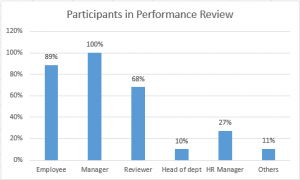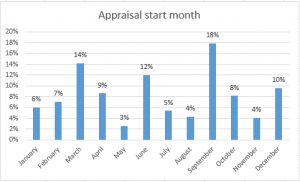Performance review is an important activity for all organizations and HR either implements a new performance review process or improves the existing process. In this procedure, HR has many queries on the performance review best practices. In my earlier blog Competencies across performance appraisals, I had analyzed the competency usage in existing performance appraisals. Analyzing 120K performance appraisals once again, I will be talking about the common trends in performance reviews. The analysis process addresses the following queries:
- » Who are the participants in performance reviews?
- » Who starts (initiates) the process?
- » How many steps does the process contain?
- » What forms are used predominantly?
- » What are the typical timelines?
What is the Performance review process
Quoting Wikipedia “A performance appraisal is a systematic and periodic process that assesses an individual employee’s job performance and productivity in relation to certain pre-established criteria and organizational objectives. Other aspects of individual employees are considered as well, such as organizational citizenship behavior, accomplishments, potential for future improvement, strengths and weaknesses, etc.”
A performance review consists of
- Participants or stakeholders who share their ratings and comments.
- Different type of Forms that capture inputs from the participants.
- Approval process or workflow: How the performance review is routed between the different participants.
- Scoring and rating guidelines: Explain how a final rating or score will lead to a perfect conclusion.
An appraisal software combines all of these together in a streamlined way to allow quick completion of the said procedure.
Who are the stakeholders of performance review process?
We could identify 6 different organization roles that were involved in the performance review process. These roles include: Employee, Manager / supervisor, Reviewer or 2nd Level manager, Head of department, HR and Others (containing many categories of employees such as project managers, dotted line managers etc. and non-employees such as clients).

In terms of participation of the said stakeholders, here is what we found:
This chart tells us that Managers’ involvement in the review process is 100%, 2nd level managers’ involvement is about 68% and HRs’ involvement is 27% in the performance review process.
The surprising insight was that about 11% reviews did not include employees at all, during the process. On digging deeper, we found that about 85% of such reviews were confirmation appraisals (where an employee is confirmed from a temp / probationer status to a permanent status). In one mid-sized manufacturing company, the employees were not involved at all in the process.
Who starts the Performance Review process?
The data clearly indicates that in about three-fourth of the cases, the performance review is started by the employee. We have observed that this trend is increasingly becoming popular where employees complete their review and submit it to their managers who complete the performance review process.

Number of steps in the Performance Review process?
The number of steps indicates the number of stakeholders who are involved before the performance appraisal is finalized.

For instance a 3-step process may include Employee, Manager and Reviewer or Employee, Manager and HR. Note: We have not included the acceptance step in the below statistics.

Predominantly organizations have a 3 step or 4 step process. In the 3 step process we observed that the largest number of workflows include the employee, the manager and the 2nd level manager (reviewer) and in the 4 step process, it additionally includes head of department or HR Manager.
What forms are used in the Performance Reviews?
There were about 850,000 forms for 120,000 appraisals. This tells us that on an average each appraisal has about 7 forms. Analyzing further, we could read the percentage of individual forms being used in the performance appraisal.

The insights from this can be outlined in the following format:
| Form | Purpose | Insight |
| 360 Feedback | Allows managers to gain feedback from multiple employees such as peers | This form is increasingly becoming popular. Managers initiate the process (inside the review) and use the inputs to fill their ratings. |
| Competency | Includes skills and competencies – in most cases as fixed sets but in some cases related to employee job roles. | Used in three-fourth of the cases. About 25% companies are not focused on assessment in this area. |
| Development Planning | Captures development needs and training feedback | Over two-thirds of companies are capturing employee development needs. It shows increasing focus on training – perhaps to increase productivity. |
| Employee profile | Displays all employment related data on the employee to managers | Since most companies use performance appraisal as a stand-alone tool, they do not display full employee records to managers. |
| Goals | Displays last year and next year goals and achievements and also (optionally) allows their setting | 132% caught us by surprise. We noticed that many companies had as many as 2 goal sheets in a single appraisal – the last years goal sheet for rating and the next year goal sheet for setting goals.
Removing this aberration, we found that about 74% appraisals contained goals based rating. |
| Introduction | Static form that helps employees understand the process and contains FAQs, timeline information etc. | Almost all companies have an appraisal introduction page.
Many of them have customized this to display different content for employees and managers. An introduction helps in communication of timelines, sets expectations etc. and is really popular. |
| Introspection | Employees enter their achievements in a textual format or answer specific questions | Many organizations have introduced this form in their performance appraisals and it is becoming very popular. |
| Manager write-up | Managers enter comments and ratings on a separate confidential form | Being used in a few organizations at the senior level roles. |
| Promotion & Increment | Includes potential assessment, at risk, promotion and increment related inputs. Typically filled by managers. | About 60% of appraisals contain this form |
| Relative ranking | Allows managers to relatively rank employees | Not a popular feature any more. |
| Submit & Final Score | Displays the final score to an employee and can capture a final rating too. | All appraisals had this option indicating that a final score and/or final rating is being captured in the reviews. |
When are the performance appraisals started?
We have been asked this question often that what is the best time to start the performance appraisal? Is it at the beginning or end of a calendar year, start or end of the financial year, based on employee anniversary etc.? The inputs tell us that organizations carry out performance appraisals at an almost equal rate throughout the year. The dominant months are March, June, September and December that maps to quarterly boundaries.









